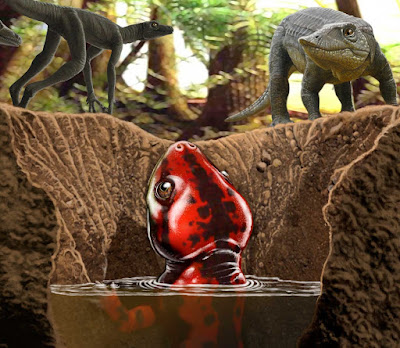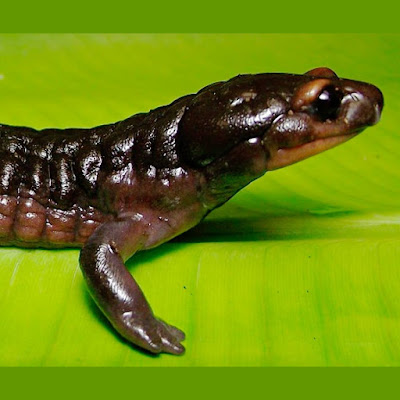![]() |
Amazona gomezgarzai
Silva, Guzmán, Urantówka & Mackiewicz, 2017
|
Abstract
Parrots (Psittaciformes) are a diverse group of birds which need urgent protection. However, many taxa from this order have an unresolved status, which makes their conservation difficult. One species-rich parrot genus is Amazona, which is widely distributed in the New World. Here we describe a new Amazona form, which is endemic to the Yucatán Peninsula. This parrot is clearly separable from other Amazona species in eleven morphometric characters as well as call and behavior. The clear differences in these features imply that the parrot most likely represents a new species. In contrast to this, the phylogenetic tree based on mitochondrial markers shows that this parrot groups with strong support within A. albifrons from Central America, which would suggest that it is a subspecies of A. albifrons. However, taken together tree topology tests and morphometric analyses, we can conclude that the new parrot represents a recently evolving species, whose taxonomic status should be further confirmed. This lineage diverged from its closest relative about 120,000 years ago and was subjected to accelerated morphological and behavioral changes like some other representatives of the genus Amazona. Our phylogenies, which are so far the most comprehensive for Amazona taxa enabled us to consider the most feasible scenarios about parrot colonization of the Greater and Lesser Antilles and Central America from South America mainland. The molecular dating of these migrations and diversification rate were correlated with climatic and geological events in the last five million years, giving an interesting insight into Amazon parrot phylogeography and their evolution in general.
![]()
![]() |
| Figure 4: Photograph of the male holotype (C and A—individual on the right) and female paratype (B and A—individual on the left) of the new Amazona. |
Amazona gomezgarzai, sp. nov. (Figs. 2–7)
Holotype. Adult male, MEXICO, the Yucatán Peninsula, south of Becanchén in Tekax Municipality. The holotype is represented by the feathers of the male, which were deposited in the collection of the Laboratorio de Ornitología, Facultad de Ciencias Biologícas, Universidad Autonóma de Nuevo León, Mexico and were assigned catalog number: MGG01-Amazona gomezgarzai-holotipo. Article 72.5.1 of the Code of Zoological Nomenclature (henceforth CODE) permits the use of animal parts in the designation of a type specimen. Upon death of the living bird, its preserved body will be paired to the feathers for a complete body. This complies with Article 16.4.2 of the CODE, which states that where the holotype is an extant individual, a statement of the intent to deposit the individual in a collection upon its death accompanied by a statement indicating the name and location of that collection is sufficient.
Paratype. Adult female collected in the same locality as the holotype. Like the holotype, feathers from this specimen have been deposited in the collection and have assigned catalog number: MGG02-Amazona gomezgarzai-alotipo. Upon its death, it will be added to the collection in Laboratorio de Ornitología, Facultad de Ciencias Biologícas, Universidad Autonóma de Nuevo León, Mexico.
Etymology. We take extreme pride in naming this parrot after Miguel Angel Gómez Garza, a Mexican veterinarian born in Monterrey (Nuevo León, Mexico) in 1960. Gómez Garza’s interest in the ecology of the parrots of Mexico spans decades and culminated in the publication of a work specifically dealing with the psittacines of that country (Gómez Garza, 2014). During his professional lifetime, Gómez Garza has been deeply involved in rehabilitating confiscated wildlife. For the last thirty years, in his private veterinary clinic (Veterinaria del Valle) in Monterrey, he has honorably supported the wildlife protection agency of the Republic of Mexico, Procuraduría Federal de Protección al Ambiente (PROFEPA), providing medical attention to confiscated wildlife suitable for being returned to their natural habitat. As a researcher in the Facultad de Medicina Veterinaria y Zootecnia of the Universidad Autonóma de Nuevo León, he is presently working on a veterinary protocol for confiscated psittacines intended for reintroduction to the wild. He brought the existence of this unique member of the genus Amazona to our attention and to him science and we owe a debt of gratitude. We suggest the common name in English: blue-winged Amazon and in Spanish: Loro de alas azules.
Distribution. The new Amazona is endemic to the Yucatán Peninsula in southern Mexico. To date, its presence is confined to an area roughly 100 km2 that is centered south of Becanchén in Tekax Municipality, Yucatán. No part of the range is presently protected in any form.
Habitat. The new Amazona is found in tropical caducifolius and subcaducifolius forest. It is also found in disturbed patches of native vegetation and in small, cultivated fields with scattered trees. It is found below 300 m above sea level.
Natural history. Miguel A. Gómez Garza first sighted this parrot in the field in trees of the Leucaena genus at heights of approximately 6 m in the beginning of 2014 during a visit to the south of Becanchén, in the municipality of Tekax. The parrots occurred in small flocks of three to five individuals and fed on the tender pods produced by this tree. During a follow up visit in August 2014, Gómez Garza also sighted pairs with their fledged young. This field work confirmed the rarity of the species and that it was far less common than the other two species found in the same area, Amazona albifrons nana and Amazona xantholora.
In normal parrot fashion, the new Amazona is diurnal, beginning the day at sunrise. It is generally secretive when resting, using its plumage as camouflage. In contrast, it is vocal and noisy in flight. The flight is moderately fast with the mechanism that is typical of the genus Amazona with wing-beats never exceeding the horizontal axis.
The new Amazona is found in small flocks of less than 12 individuals, which were studied in the field. Pairs and their progeny have a tendency to remain together and are discernible in groups. Like all members of the genus Amazona, this parrot is herbivore. Its diet consists of seeds, fruits, flowers and leaves obtained in the tree canopy. It also consumes tender shoots of native trees and the pods of leguminous trees including uaxim (Leucaena glauca), bukut (Cassia grandis) and katsín (Acasia gaumeri).
Very little is known about this parrot’s biology. There is no conservation program currently in effect to preserve this parrot but its long-term existence impinges on the local communities and making them aware of this parrot’s value as a result of its uniqueness, its potential as a bird watching attraction and the fact that it is present only locally. Its small range and rarity should make its conservation a priority.
Tony Silva, Antonio Guzmán, Adam D. Urantówka and Paweł Mackiewicz. 2017. A New Parrot Taxon from the Yucatán Peninsula, Mexico — Its Position within Genus
Amazona based on Morphology and Molecular Phylogeny.
PeerJ. 5:e3475. DOI:
10.7717/peerj.3475

























































































